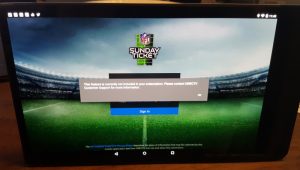Today I’m in luck: CBS is showing the Patriots-Bills football game this afternoon. As a Patriots fan who lives in North Carolina, however, I’m frequently not so fortunate.
The unfortunate fact is that I and millions of other football fans outside their team’s local markets have few alternatives for watching the games we desire.
Furthermore, those alternatives are so complex, arcane, and flawed that the entire mess makes a wonderful digital case study – that is, a case study of precisely how not to do digital.
 The NFL’s Quixotic Anti-Fan History
The NFL’s Quixotic Anti-Fan History
I define digital as customer preferences and behavior drive enterprise technology decisions – and in this case, this particular customer simply wants to watch each Patriots game, either on TV or on a tablet. In addition, I want to watch the entire game, and I want to watch it live.
Furthermore, I’m willing to pay for the privilege – either by suffering through the ads, or even by paying a fee as well. Perhaps I might even cough up the dough to see them in person at some point.
I – and most fans, I presume – do not begrudge the NFL the money it makes. That is, unless we can’t watch our favorite team play.
You would think, therefore, that delivering game viewing to fans would be its top priority, as every dollar it makes, every licensed product it sells, derives from fans’ essential demand for watching the game.
Yet the NFL’s history is littered with anti-fan policies that the commissioner at the time may have thought would drive profits, but in reality, had the opposite effect.
Long before video streaming, in fact, the NFL’s blackout policies confounded die-hard fans across the country. If a stadium didn’t sell out, the reasoning went, then the NFL would forbid local television stations from airing the game.
The goal was to put butts in seats – but what the NFL didn’t realize for many years was that putting the fans’ butts in their armchairs at home where they could watch the ads was even more lucrative – especially as cable TV rose to prominence in the 1980s.
Missing the impact of technology evolution on their market proved to be an NFL calling card, as blackout rules survived well into the 2010s. Today, the boat the NFL is missing is perhaps even larger than cable: the rise of ‘over the top’ (OTT) services, or in common parlance: streaming, interactive digital content.
Read the entire article at http://www.forbes.com/sites/jasonbloomberg/2016/10/30/nfl-and-att-directv-cohorts-in-digital-disaster/.
Intellyx publishes the Agile Digital Transformation Roadmap poster, advises companies on their digital transformation initiatives, and helps vendors communicate their agility stories. As of the time of writing, none of the organizations mentioned in this article are Intellyx customers. Image credit: Jason Bloomberg.



